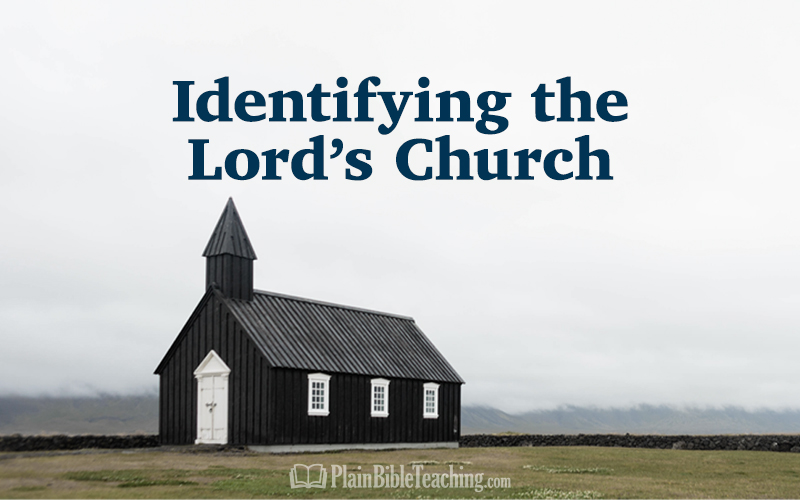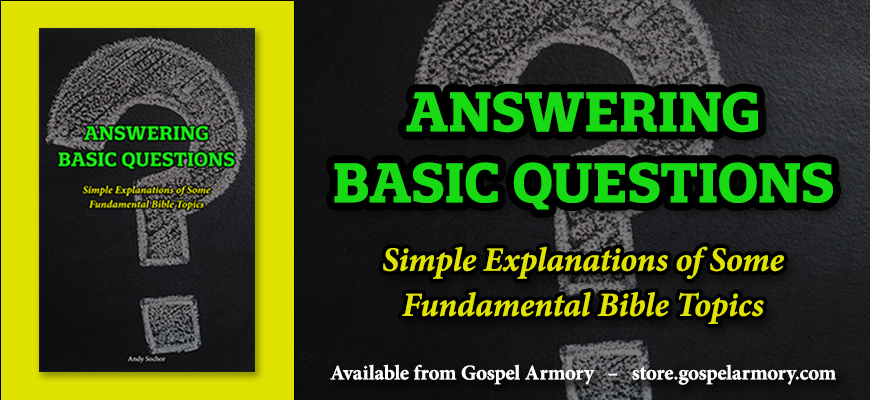
As we look at the religious landscape around us, we see a myriad of churches that exist. How did all of these churches come to be? That is certainly a study in itself. For our purposes here, we want to answer this question: How many churches did Jesus build?
Jesus Built ONE Church
When Jesus met with His disciples in Caesarea Philippi, He asked, “Who do people say that the Son of Man is?” (Matthew 16:13). After they responded with different answers that others would have given to that question, He turned the question toward them: “But who do you say that I am?” (Matthew 16:15). Peter spoke up and answered Jesus’ question correctly: “You are the Christ, the Son of the living God” (Matthew 16:16). This fact was important – not only because it identified Jesus, but also because this would have an impact on the church.
“And Jesus said to him, ‘Blessed are you, Simon Barjona, because flesh and blood did not reveal this to you, but My Father who is in heaven. I also say to you that you are Peter, and upon this rock I will build My church; and the gates of Hades will not overpower it’” (Matthew 16:17-18).
The fact that Jesus was “the Christ, the Son of the living God” was the foundation upon which His church would be built. Understanding that the church is His church and that He is “the Christ, the Son of the living God” is necessary to answer the other questions we will consider in the subsequent lessons of this study.
In addition to that, notice that Jesus promised to build His church (singular). In other words, Jesus did not tell His disciples that He was going to build a plurality of churches; He was going to build just one church.
Paul explained to the brethren in Ephesus, “And [the Father] put all things in subjection under [Jesus’] feet, and gave Him as head over all things to the church, which is His body, the fullness of Him who fills all in all” (Ephesians 1:22-23). Jesus is the head over the church (singular). Again, the Bible indicates that Jesus has just one church.
Later in the letter to Ephesus, Paul used the illustration of a marriage relationship to describe the relationship between Jesus and the church (Ephesians 5:22-24, 32). When God established the institution of marriage, He made it to be between one man and one woman (Ephesians 5:31; Genesis 2:24) – not one man and multiple women. In the same way, we read about Jesus with His one church.
However, the New Testament does also speak of churches (plural). When Paul wrote to the saints in Rome, he said, “All the churches of Christ greet you” (Romans 16:16). What is the difference between the singular and plural uses? One we are added to, the other we join (Acts 2:47; 9:26). Let us consider these points further.
The Universal Church
The one church that Jesus built (singular) is the universal church. Though the term “universal church” is not used in the New Testament, the concept is described. But we need to be sure we properly understand the concept if we are to use this term.
When the New Testament refers to the one church, this is the body of all those who are saved. On the day of Pentecost when the gospel began to be preached and people started responding to it, Luke recorded, “And the Lord added to the church daily such as should be saved” (Acts 2:47, KJV). Those who were being saved were added to the one church. In describing the relationship between Jesus and the church by using the illustration of the marriage relationship, Paul wrote, “Christ also is the head of the church, He Himself being the Savior of the body” (Ephesians 5:23). If Jesus is the Savior of the body (the church), that means the church is the body of the saved.
This also means that there is no salvation outside of Christ. Peter affirmed this when he and John appeared before the Jewish council: “And there is salvation in no one else; for there is no other name under heaven that has been given among men by which we must be saved” (Acts 4:12). Therefore, if anyone is saved, it will be through Christ in the church that He built.
In the third lesson we will discuss who is in the church. But for now, the point we need to remember is that God is the one who adds people to the church (Acts 2:47).
Local Churches
There is one universal church, yet there are many local churches – congregations in different locations. Notice just a few passages that make this clear:
- “The news about them reached the ears of the church at Jerusalem, and they sent Barnabas off to Antioch” (Acts 11:22). After a while, Barnabas found Saul and “brought him to Antioch” where they “met with the church” (Acts 11:25-26). There was one church in Jerusalem that sent Barnabas to Antioch and another church in Antioch where Barnabas and Saul labored.
- “Greet one another with a holy kiss. All the churches of Christ greet you” (Romans 16:16). There were several churches with which Paul was associated. He also told the Corinthians that he taught the same thing “everywhere in every church” (1 Corinthians 4:17), indicating a multitude of local churches.
- The book of Revelation was addressed “to the seven churches that are in Asia” (Revelation 1:4). The seven churches were located in Ephesus, Smyrna, Pergamum, Thyatira, Sardis, Philadelphia, and Laodicea (Revelation 2:1, 8, 12, 18; 3:1, 7, 14).
How do we reconcile the fact that Jesus only built one church with the above passages?
God adds those who are saved to the universal church (Acts 2:47). Then those who have been added to this church will work together as part of local churches. Consider the following passages:
- “But in case I am delayed, I write so that you will know how one ought to conduct himself in the household of God, which is the church of the living God, the pillar and support of the truth” (1 Timothy 3:15). Timothy was to conduct himself in a certain way within the church. This was not referring to the universal church; rather, this was the local church. We know this by the context. Paul was referring to the church that was overseen by elders and served by deacons (1 Timothy 3:1-13) – the local church.
- “From whom the whole body, being fitted and held together by what every joint supplies, according to the proper working of each individual part, causes the growth of the body for the building up of itself in love” (Ephesians 4:16). This body that has individual members working together was the local church where love could be shown to one another (Ephesians 4:2); unity could be maintained (Ephesians 4:3-6); and evangelists, pastors, and teachers could work to equip the saints (Ephesians 4:11-12).
- “Now you are Christ’s body, and individually members of it” (1 Corinthians 12:27). In this passage, Paul described Christians functioning together as part of a body. There is no practical way this can be done on a universal level. Christians work together in the context of the local church with each one performing different functions within the group.
Because local churches involve Christians working together, we must of necessity join and be received by a particular church. For example, when Paul (then Saul) came to Jerusalem after becoming a Christian in Damascus, he tried “to join himself to the disciples” (Acts 9:26). He had already been added by God to the universal church. We know this because he, based upon his belief in Christ, was baptized (Acts 9:18) – the same thing that those on Pentecost did which resulted in God adding them to the church (Acts 2:41, 47). Yet he needed to join and be received by the church in Jerusalem before he could be counted as part of their number. As part of that congregation, he was then able to participate in the work with them. The same is true for us today. We indicate a desire join a local church, are received by that church, then we can participate in the work of the church. What we are to do when we come together in a local church will be discussed in the fourth lesson.
Other Churches
The reality is that there are many different churches in the world. This is evident to everyone who observes the religious world. This brings up two very important questions:
- Are the people who make up these churches part of the universal church (the one Jesus built)?
- Are all congregations simply local churches like the ones we read about in the New Testament?
How can we answer those questions? How can we identify the Lord’s church? This is what this study is all about. We need to be able to answer the following questions:
- What rule does His church follow?
- Who makes up His church?
- What is His church to be doing?
By answering these questions, we will be able to identify the Lord’s church.
Conclusion
Jesus built just one church and salvation is only found in His church. If we want to be saved, we need God to add us to this church.*
–––
*We will discuss this further in the third lesson.











[…] the previous lesson, we discussed the question regarding the number of churches that Jesus built. We saw from the Scriptures that He built just one church. Yet we need to know how His one church […]